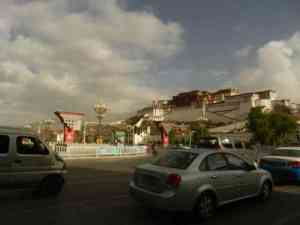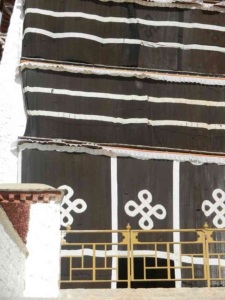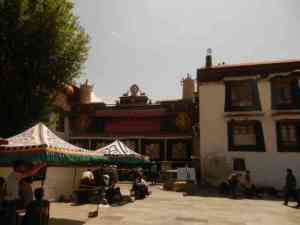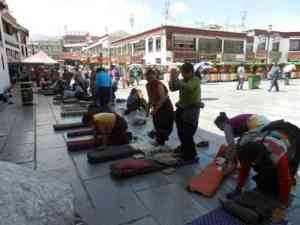 |
| 1. View of Potala Palace, Shangri-La |
I am blessed. What other woman has her own sherpa couple having her back and side but more, continually chanting prayers as she climbs 350 feet of crude stairs – and of course going back down them – at the Potala Palace in Tibet? It’s the life. That’s what Nema and Phurea do for me. Everyone sort of shakes when I have to go down stairs in sets of 12 in the dark corners of palaces and monasteries with about only 6 inches to hold a shoed foot. Potala Palace has 13 floors (all of which we climbed) and 999 rooms (no we did not visit all) and took 50 years to be built and is earthquake proof. I believe this palace was the resource for the idea of Shangra La, where peace and happiness existed. Guru Rimpoche wrote that it existed in the land of snow in a valley filled with compassion – possibly ancient holy lamas went there to die. Hollywood took on this story in a 1940s movie I never forgot. Now I’m here. It’s huge.
 |
| 2. Yak hair curtains |
I really didn’t believe I could make it up to the top of the Palace, which was the residence of all the Dalai Lamas for centuries. It looked like a Mount Everest event to me but the stairs leading up to the holy area, packed with Chinese tourist no matter if they are Buddhist or not, were roomy and made with rocks happily doable, although I was worried for awhile. We passed through large black curtains woven from yak hair – that stops water from entering and allows us to enter. Once we had climbed to the area of the palace where walls were made of tightly pressed sticks painted dark red, then the serious work began. That was the holy area, no photos allowed. Guards dressed in orange were everywhere to move crowds along. Tibetans could meander as long as they wished. Foreigners had one hour to get through all the detailed chapels dedicated to the Dalai Lamas in all their glory.
Nema and his wife are old friends. Nema was my personal sherpa four years ago when I went to Everest base camp. But he has had bigger challenges than me. He has summited Mt. Everest 10 times and was sherpa to the sons of Edmund Hilary, the first person to summit Everest in 1954 and his sherpa, Tensing Norgay. when they attempted successfully to duplicate their fathers’ climb in 2004. Nema always smiles and always grabs my arm or elbow. Sometimes I have to say, “I can do it.” Because, most of the time I can. He has, though, stopped me sliding off many a narrow rocky path en route to Everest base camp. And he was the one who made sure we hung the prayer flags I had carried in 2008 made by girls in detention and the precious classmates of my then first grade granddaughter Megan. Now we have a bag loaded with new prayer flags from granddaughter Caroline’s St.Mary’s lower school to be hung on the Tibet side of Everest base camp – and some at the holy Mt. Kailash.
 |
| 3. Mean protector god |
But back to Lasha: the art trove hidden within walls of Potala Palace, a national treasure, would make Rome’s Vatican gasp. Ornate wouldn’t sufficiently describe even a tiny corner. Never have I seen so many golden images of Buddha – life size or bigger, wearing all sorts of wardrobes and carrying possessions which related to each particular role the Buddha transformes into. There are 330 Buddha possibilities. Of the three main Buddhas, present, future and compassion (who has a thousand hands and a thousand eyes), the most unique is the future Buddha who unlike others does not sit in the Lotus style and his feet are ready to stand up. He has long eyes that are open wide and not shut like most Buddhas because he is looking for compassion. He has blue hair, long hair and long ears.
In many rooms you are greeted by enormous blue faced scowling monster figures – these are the protection gods – warning you to get your karma right before you bow and offer gifts. And in this Palace, a museum of the history of 14 Dalai Lamas, giant thrones (the size of chair-and-a-halfs, almost small beds – they sit cross-legged no matter how old they were) abound in each Lama’s chapel, a cape neatly folded into a triangle like a witches hat and placed in the seat which the current Dalai Lama would occupy if he could be there.
 |
| 4. My Rocky dance |
Then there are gigantic gold and bejeweled stupas inside the Palace that are tombs for the long line of Dalai Lamas who have existed and been reincarnated. These are elaborately displayed in various chapels at the very top of the building closest to the heavens. And also at the very top is the balcony draped in gleeful flying yellow fabric where the the Dalai Lama to observe activities way below in the open area when monks, holy men and/or admirers come to visit, to preform ceremonies and to offer gifts, sort of like the Pope’s window at the Vatican, and the English Royal Family’s balcony at Buckingham Palace.
There is so much information about Buddhism eagerly spilled out by our guide Tashe who has such a brutal accent I cannot understand much, I began to fade by the end of our time up there wandering in order through each segment. Finally I could get a bottle of water. I felt like Rocky when I got to the very top and then again when I got back to the bottom (since we couldn’t take a photo at the top.)
Our day started early getting to the Palace. We were diverted because every morning thousands of pilgrims and worshippers dressed in their Tibetan native costumes and carrying prayer wheels and prayer beads, daily walk the 8 kilometer route around the Inner City, which is the holy part of Lasha. It’s impressive. Most of them are old. Many do it prostrating themselves. They ignore the stacks of tourist (mostly Chinese) lining up for their entrance into Potala. Of all the visitors, I saw one group of retired Americans carrying hiking sticks, a group of Russians, and a pair of Germans. All the others were Chinese, it seemed. I’m told 70 per cent of all tourism in China comes from their own citizens. There is much to see in beautiful settings.
 |
| 5. Jokhang Temple |
When we left Potala we drove a short way to a China-huge type square that fronts the Jokhang Temple, known as the Water Blessing Temple, the most revered religious structure in Tibet, thick with smell of yak butter, mantras, incense and offerings. It is the destination of so many pilgrims that it’s hard to feel good about being a non-Buddhist stepping on their floors. Jokhang was built 639-ish by a Tibetan King Songtsen Gampo, the king who brought Buddhism to Tibet with his two Tara wives (one chinese and one nepali). It copies the passion of the Muslim’s call to Mecca or the sinful crawling on their knees to Guadalupe in Mexico. All faithful need to make a pilgrimage to build merit in their lives. Tibetans get here one way or the other in their native dress, with striped aprons, their soft handsewn shoes, and bringing bags of butter, all sorts of Khata scarves, money, prayer flags (you can purchase what you forgot before you enter) and the incense and bodily odor knocks you out. In a locked room with big windows were 1000 burning butter lamps, similar to the Christian light candles for loved ones or the sick. That was hot.
 |
| 6. Prostrate pilgrims at Jokhang |
All have to go through security – always – in these popular places. The plaza was filled with a different kind of armed police force in black uniforms, due to problems in the past. But I felt a wave of uncomfortablity in such a dark place, with so many people seeking resolution and help, many prostrate, others hungry to leave some sort of offering to get their souls corrected and their karma on track toward enlightenment. I could not stay there. I felt as though i was intruding, even though there was a group of American tourists going through without sensing the power and pain being dealt with around them. This, to me, is where sightseeing stops and respect for faith moves in. So I left and waited outside for my Tibetan friends and prayed the Lord’s Prayer many times.

Audrey,
After the rigors and hardships of Kathmandu, it appears that you have really found Shangri La. The St. Regis Hotel with mood lighting in the bathroom, Samye and Jokhang Temples and the Potala Palace are beautiful. It comforting for us to know you are in a safer envorinment.
When do you find time to gather all of the information you are including in your blogs? Do you ever sleep? You are absolutely amazing!
Audrey, you are in our prayers every day. We miss you.
Love you,
Geraldean and Judge
Opps!
The word obviously is
“environment.”
Dear Audrey:
Thank you for the detailed descriptions and photographs. I was interested in Buddhism when I was in college and law school. I will be interested to hear your take on it when you return.
Be careful and enjoy the rest of your adventure.
Sincerely,
Chuck Weirich